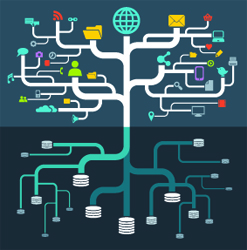Feature Stories -The network of the future, beyond theory
Experts predict the future networked society will be the result of a merger of the physical and digital worlds, thanks to the explosive growth of wireless sensor networks in everything from vehicles to raincoats. Objects will be able to identify and locate each other, and 'chat amongst themselves', through advanced radio interfaces. Self-organised 'edge networks' - providing enhanced data rates for mobile and smart telephones - will become more common. People will be able to borrow bandwidth or piggyback on 'sharer' networks if they find themselves out of coverage. The fixed networking environments and relationships that define today's infrastructure will evolve into ad-hoc relationships with greater flexibility and autonomy to meet the needs and budgets of users on the go. Much of this fancy-sounding functionality is already available, or in the pipeline, thanks to developments in late-generation smart phones and networks. But technologists are not resting on their laurels. This fast-evolving networking environment requires forward-looking research and governance policies, and may involve whole new principles and methods to design, develop, control and manage future multi-technology architectures. Dealing with the diversity of these scientific and socio-economic challenges calls for an integrated, end-to-end approach. This is where the EU-funded project 'Anticipating the network of the future - from theory to design' (EURO-NF) stepped in. Collective intelligence The 54-month project pooled the talents of a whopping 35 partners from all over Europe and Israel. EURO-NF thus built on the successful EURO-NGI/FGI 'Network of Excellence', funded under FP6, to form the largest 'Collective intelligence think tank' on networks of the future so far, and help establish and stimulate European expertise in the field of future networks. 'EURO-NF was like a funnel with several outlets,' says Markus Fiedler, professor at Blekinge Institute of Technology (BTH), Sweden, a EURO-NF partner. Existing work, new ideas and initiatives from the partners are entered at one end, he continues, and these are channelled into new projects and research directions with corresponding results and publications that benefit the European R&D landscape, including well-trained and networked students. EURO-NF managed a gruelling schedule of integrating activities, such as researcher exchanges, summer schools, producing a knowledge map, and a series of events and workshops covering a range of topics, from next-generation internet developments and new trends in modelling to socio-economic issues affecting future networks. Innovation-rich projects Joint research projects aimed at improving knowledge in innovation-rich but under-represented areas were also supported within the EURO-NF framework. According to the team, these projects needed to be 'sharply focused, preferably on disruptive ideas on the networks of the future, and designed to gain new knowledge and explore the need for more research effort, anticipating scientific and technological needs'. Take, for example, the joint project 'Impacts of network neutrality on the internet stakeholders' (INNIS) from EURO-NF's fifth call, which studied the question of network neutrality. This is a subject of 'vivid debate', according to the project team. They set out to elaborate and analyse models to investigate the potential consequences of network neutrality policies on the network ecosystem (with end-users, connection providers, content providers, and regulatory entities). Meanwhile, the joint project 'Context-aware information dissemination in vehicular networks' (Cave-Net) investigated how, for example, taxi companies and public transport services, can leverage context-aware information - vehicle location, velocity, proximity, traffic density, delays, etc. - to improve service and performance. On its web-portal, EURO-NF outlines in detail its many projects, events, integrating and dissemination activities, including a long list of publications from its research partners, and a link to the EURO-NF vision statement. 'This "vision" is in fact the result of a long-term, continuous brainstorming that we've been carrying out since our former project EURO-NGI,' says Kurt Tutschku, professor for Future Communication at the University of Vienna (endowed by A1TelekomAustria AG) and currently guest professor at BTH. He is the lead author of the vision statement. Ambitious? Yes. But by leveraging the knowledge and market position of consortium partners, including industrial players, EURO-NF is helping to convert theoretical possibilities into innovative future network solutions and applications which benefit Europe and the economy. --- The EURO-NF project received EUR 4.8 million (of total EUR 20 million project budget) in research funding under the EU's Seventh Framework Programme (FP7). Link to project on CORDIS: - FP7 on CORDIS - EURO-NF project factsheet on CORDIS Link to project's website: - 'Anticipating the network of the future - from theory to design' project website - EURO-NF portal - EURO-NF Vision Links to related news and articles: - Polish scientific pedigree - Copernicus to Curie, and beyond - Using wireless interference to advantage - Broadband - 'big-pipes' of potential growth



